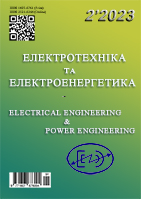Spectral method of electrical circuits accelerated simulation with thyristors
DOI:
https://doi.org/10.15588/1607-6761-2023-02-03Keywords:
electric circuits, orthogonal polynomials, differential equations, numerical methods, spectral methods, approximation, Chebyshev polynomials, transient processes, schematic modelAbstract
Purpose. The development of transient processes calculation method in electric circuits with thyristors based on the use of functions approximation by orthogonal polynomials.
Methodology. Functions approximation by orthogonal polynomials, numerical methods of differential equations integration, matrix methods, programming, theory of electric circuits.
Obtained results. The method of solution function polynomial approximation of integro-differential equations of state, which describes the transient processes of an electric circuit with thyristors, is used in this paper. The used method showed the advantages over other known methods in increasing the accuracy and reducing the simulation time of transient electrical processes by more than 6 times.
Findings. The solution is approximated by a series of Chebyshev polynomials. The integro-differential equations of state are transformed into linear algebraic equations for special depiction of the solution functions. The depiction of functions of true currents in the equivalent circuit is interpreted as direct currents. Such a schematic model creates visibility for a researcher performing simulation of transient electrical processes.
Practical value. The proposed methods discover the possibility of using the apparatus of direct current electric circuits’ theory for transient processes in complex schemes modeling with thyristors.
References
Zhuikov V.Ya and others. (1988) Automated design of power electronic circuits
Yagup V.G. (1968) Automated design of thyristor cir-cuits
Boyd, J. P. (2001). Chebyshev and Fourier spectral methods. Courier Corporation.
Epperson, James F., (2013). An introduction to numerical methods and analysis / James F. Epperson, Mathematical Reviews. ISBN 978-1-118-36759-9
Gourgoulhon, E., Bonazzola, S., Grandclément, P., Marck, J. A., & Novak, J. (2002, September). Intro-duction to spectral methods. In 4th EU Network meeting, Palma de Mallorca (Vol. 175, p. 176).
Costa, B. (2004). Spectral Methods for Partial Differential Equations. CUBO, A Mathematical Journal, 6(4), 1–32. Retrieved from https://cubo.ufro.cl/ojs/index.php/cubo/article/view/1552
Kopriva, D. A. (2009). Implementing spectral methods for partial differential equations: Algorithms for scientists and engineers. Springer Science & Business Media.
Trefethen, L. N. (2000). Spectral methods in MATLAB. Society for industrial and applied mathematics.
Tykhovod, S., & Patalakh, D. (2019, September). Cal-culation of Transients in Electrical Circuits at the Use of Solution Approximation by Tchebyshev's Poly-nomials. In 2019 IEEE 20th International Confer-ence on Computational Problems of Electrical Engi-neering (CPEE) (pp. 1-4). IEEE. DOI: https://doi.org/10.1109/CPEE47179.2019.8949129
Boyd, J. P., & Petschek, R. (2014). The relationships between Chebyshev, Legendre and Jacobi polynomials: the generic superiority of Chebyshev polynomials and three important exceptions. Journal of Scientific Computing, 59, 1-27. DOI: https://doi.org/10.1007/s10915-013-9751-7
Tykhovod, S., & Orlovskyi, I. (2022). Development and Research of Method in the Calculation of Tran-sients in Electrical Circuits Based on Polynomials. Energies, 15(22), 8550. DOI: https://doi.org/10.3390/en15228550
Program for calculating the transient process by the special method in the RLCe circuit. Retrieved from: https://drive.google.com/file/d/1PVHWp9caGdHy_L8AMR39VTtogw0ylcGY/view?usp=sharing
Tykhovod S.M. Afanasieva I.O., Kornus T.M. (2009) Development of a computer program for the simula-tion of magnetoelectric circuits with thyristors. Tech-nical electrodynamics. 3(9-14)
Tykhovod S.M. (2000) Methodology for computer simulation of electrical circuits containing semicon-ductor valves. Electrical engineering and power engi-neering. 2(50-52).
Downloads
Published
How to Cite
Issue
Section
License
Copyright (c) 2023 С.М. Тиховод, Т.Є. Дівчук , Т.П. Солодовнікова, О.В. Ситік

This work is licensed under a Creative Commons Attribution-ShareAlike 4.0 International License.
Creative Commons Licensing Notifications in the Copyright Notices
Authors who publish with this journal agree to the following terms:
Authors retain copyright and grant the journal right of first publication with the work simultaneously licensed under aCreative Commons Attribution License that allows others to share the work with an acknowledgement of the work's authorship and initial publication in this journal.
Authors are able to enter into separate, additional contractual arrangements for the non-exclusive distribution of the journal's published version of the work (e.g., post it to an institutional repository or publish it in a book), with an acknowledgement of its initial publication in this journal.
Authors are permitted and encouraged to post their work online (e.g., in institutional repositories or on their website) prior to and during the submission process, as it can lead to productive exchanges, as well as earlier and greater citation of published work.

